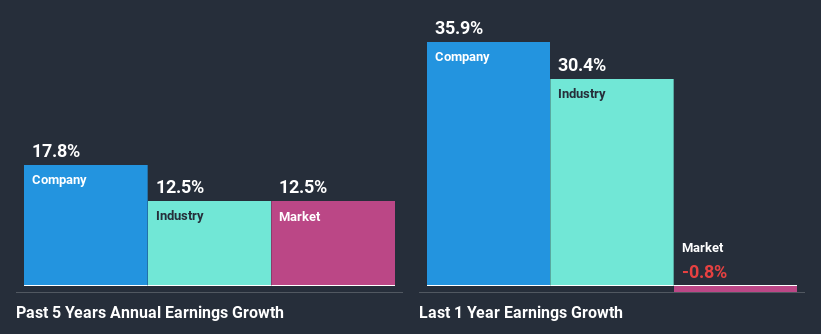Thermo Fisher Scientific Inc.'s (NYSE:TMO) Recent Stock Performance Looks Decent- Can Strong Fundamentals Be the Reason?
Thermo Fisher Scientific's (NYSE:TMO) stock is up by 8.6% over the past three months. Given its impressive performance, we decided to study the company's key financial indicators as a company's long-term fundamentals usually dictate market outcomes. In this article, we decided to focus on Thermo Fisher Scientific's ROE.
Return on equity or ROE is a key measure used to assess how efficiently a company's management is utilizing the company's capital. In other words, it is a profitability ratio which measures the rate of return on the capital provided by the company's shareholders.
View our latest analysis for Thermo Fisher Scientific
How To Calculate Return On Equity?
Return on equity can be calculated by using the formula:
Return on Equity = Net Profit (from continuing operations) ÷ Shareholders' Equity
So, based on the above formula, the ROE for Thermo Fisher Scientific is:
15% = US$4.9b ÷ US$32b (Based on the trailing twelve months to September 2020).
The 'return' is the income the business earned over the last year. That means that for every $1 worth of shareholders' equity, the company generated $0.15 in profit.
What Has ROE Got To Do With Earnings Growth?
We have already established that ROE serves as an efficient profit-generating gauge for a company's future earnings. Depending on how much of these profits the company reinvests or "retains", and how effectively it does so, we are then able to assess a company’s earnings growth potential. Generally speaking, other things being equal, firms with a high return on equity and profit retention, have a higher growth rate than firms that don’t share these attributes.
Thermo Fisher Scientific's Earnings Growth And 15% ROE
At first glance, Thermo Fisher Scientific seems to have a decent ROE. And on comparing with the industry, we found that the the average industry ROE is similar at 15%. This probably goes some way in explaining Thermo Fisher Scientific's moderate 18% growth over the past five years amongst other factors.
Next, on comparing with the industry net income growth, we found that Thermo Fisher Scientific's growth is quite high when compared to the industry average growth of 13% in the same period, which is great to see.
Earnings growth is a huge factor in stock valuation. What investors need to determine next is if the expected earnings growth, or the lack of it, is already built into the share price. This then helps them determine if the stock is placed for a bright or bleak future. One good indicator of expected earnings growth is the P/E ratio which determines the price the market is willing to pay for a stock based on its earnings prospects. So, you may want to check if Thermo Fisher Scientific is trading on a high P/E or a low P/E, relative to its industry.
Is Thermo Fisher Scientific Using Its Retained Earnings Effectively?
In Thermo Fisher Scientific's case, its respectable earnings growth can probably be explained by its low three-year median payout ratio of 8.9% (or a retention ratio of 91%), which suggests that the company is investing most of its profits to grow its business.
Moreover, Thermo Fisher Scientific is determined to keep sharing its profits with shareholders which we infer from its long history of nine years of paying a dividend. Our latest analyst data shows that the future payout ratio of the company is expected to drop to 5.2% over the next three years. As a result, the expected drop in Thermo Fisher Scientific's payout ratio explains the anticipated rise in the company's future ROE to 21%, over the same period.
Summary
In total, we are pretty happy with Thermo Fisher Scientific's performance. Specifically, we like that the company is reinvesting a huge chunk of its profits at a high rate of return. This of course has caused the company to see substantial growth in its earnings. With that said, the latest industry analyst forecasts reveal that the company's earnings growth is expected to slow down. To know more about the latest analysts predictions for the company, check out this visualization of analyst forecasts for the company.
This article by Simply Wall St is general in nature. It does not constitute a recommendation to buy or sell any stock, and does not take account of your objectives, or your financial situation. We aim to bring you long-term focused analysis driven by fundamental data. Note that our analysis may not factor in the latest price-sensitive company announcements or qualitative material. Simply Wall St has no position in any stocks mentioned.
Have feedback on this article? Concerned about the content? Get in touch with us directly. Alternatively, email editorial-team@simplywallst.com.



